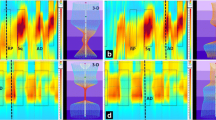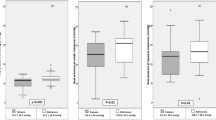Abstract
Biofeedback is a well-known and effective treatment for patients with fecal evacuation disorder (FED). The main purpose of this study was to investigate the outcome and the effects of biofeedback therapy on physiological parameters as assessed by manometry in patients with FED. Data from 114 consecutive patients with FED who underwent biofeedback therapy in Sara Gastrointestinal clinic in Tehran, Iran during 2015–2018 were retrospectively reviewed and analyzed. All participants underwent a comprehensive evaluation of anorectal function that included anorectal manometry and a balloon expulsion test at the baseline and after biofeedback therapy. Maximum anal squeeze pressure and sustained anal squeeze pressure were improved up to 100% and 94.7% of normal values in the patients after biofeedback, respectively (P < 0.001). First rectal sensation, was significantly decreased (25 ± 18.5 vs. 15.5 ± 5.2) while the maximum tolerable volume was significantly increased (233.6 ± 89.7 vs. 182.4 ± 23.1) after biofeedback therapy (P < 0.001). Type I dyssynergia was the most common type, effecting 82 cases (71.9%) of our patients. Dyssynergia parameters were improved 50–80% in 34 (41.5%) and 10 (31.3%) type I and non-type I patients, respectively. Over 80% improvement of dyssynergia parameters occurred in 48 (58.5%) and 22 (68.8%) type I and non-type I patients, respectively. These differences were not statistically significant between the two groups (P = 0.3). In addition, the ability to reject the balloon was significantly better in post intervention measurements (P < 0.001). Biofeedback not only improves the symptoms in patients of FED but also reverses more than 80% the dyssynergic parameters of defecation. However, due to the general effectiveness of biofeedback treatment in different types of DD, there were no significant differences between their improvement scores.



Similar content being viewed by others
References
Ahadi, T., Madjlesi, F., Mahjoubi, B., Mirzaei, R., Forogh, B., Daliri, S. S., et al. (2014). The effect of biofeedback therapy on dyssynergic constipation in patients with or without Irritable Bowel Syndrome. Journal of Research in Medical Sciences, 19(10), 950–955.
Andrews, C. N., & Storr, M. (2011). The pathophysiology of chronic constipation. Canadian Journal of Gastroenterology and Hepatology, 25 Suppl B, 16B–21B.
Arhan, P., Faverdin, C., Devroede, G., Besancon-Lecointe, I., Fekete, C., Goupil, G., et al. (1994). Biofeedback re-education of faecal continence in children. International Journal of Colorectal Disease, 9(3), 128–133.
Bellini, M., Gambaccini, D., Usai-Satta, P., De Bortoli, N., Bertani, L., Marchi, S., et al. (2015). Irritable bowel syndrome and chronic constipation: Fact and fiction. World Journal Gastroenterol, 21(40), 11362–11370. https://doi.org/10.3748/wjg.v21.i40.11362.
Bharucha, A. E., Pemberton, J. H., & Locke, G. R., 3rd. (2013). American Gastroenterological Association technical review on constipation. Gastroenterology, 144(1), 218–238. https://doi.org/10.1053/j.gastro.2012.10.028.
Binnie, N. R., Papachrysostomou, M., Clare, N., & Smith, A. N. (1992). Solitary rectal ulcer: The place of biofeedback and surgery in the treatment of the syndrome. World Journal Surgery, 16(5), 836–840.
Cali, R. L., Blatchford, G. J., Perry, R. E., Pitsch, R. M., Thorson, A. G., & Christensen, M. A. (1992). Normal variation in anorectal manometry. Diseases of the Colon & Rectum, 35(12), 1161–1164.
Chaliha, C., Sultan, A. H., & Emmanuel, A. V. (2007). Normal ranges for anorectal manometry and sensation in women of reproductive age. Colorectal Disease, 9(9), 839–844. https://doi.org/10.1111/j.1463-1318.2007.01212.x.
Chiarioni, G., Salandini, L., & Whitehead, W. E. (2005). Biofeedback benefits only patients with outlet dysfunction, not patients with isolated slow transit constipation. Gastroenterology, 129(1), 86–97.
Chiarioni, G., Whitehead, W. E., Pezza, V., Morelli, A., & Bassotti, G. (2006). Biofeedback is superior to laxatives for normal transit constipation due to pelvic floor dyssynergia. Gastroenterology, 130(3), 657–664. https://doi.org/10.1053/j.gastro.2005.11.014.
Chiotakakou-Faliakou, E., Kamm, M. A., Roy, A. J., Storrie, J. B., & Turner, I. C. (1998). Biofeedback provides long-term benefit for patients with intractable, slow and normal transit constipation. Gut, 42(4), 517–521.
Dailianas, A., Skandalis, N., Rimikis, M. N., Koutsomanis, D., Kardasi, M., & Archimandritis, A. (2000). Pelvic floor study in patients with obstructive defecation: Influence of biofeedback. Journal of Clinical Gastroenterology, 30(2), 176–180.
Emmanuel, A. V., & Kamm, M. A. (2001). Response to a behavioural treatment, biofeedback, in constipated patients is associated with improved gut transit and autonomic innervation. Gut, 49(2), 214–219.
Forootan, M., Bagheri, N., & Darvishi, M. (2018). Chronic constipation: A review of literature. Medicine, 97(20), e10631. https://doi.org/10.1097/MD.0000000000010631.
Glia, A., Gylin, M., Akerlund, J. E., Lindfors, U., & Lindberg, G. (1998). Biofeedback training in patients with fecal incontinence. Diseases of the Colon & Rectum, 41(3), 359–364.
Glia, A., Gylin, M., Gullberg, K., & Lindberg, G. (1997). Biofeedback retraining in patients with functional constipation and paradoxical puborectalis contraction: Comparison of anal manometry and sphincter electromyography for feedback. Diseases of the Colon & Rectum, 40(8), 889–895.
Heinrich, H., Fruehauf, H., Sauter, M., Steingotter, A., Fried, M., Schwizer, W., et al. (2013). The effect of standard compared to enhanced instruction and verbal feedback on anorectal manometry measurements. Neurogastroenterology & Motility. https://doi.org/10.1111/nmo.12038.
Heymen, S., Scarlett, Y., Jones, K., Ringel, Y., Drossman, D., & Whitehead, W. E. (2007). Randomized, controlled trial shows biofeedback to be superior to alternative treatments for patients with pelvic floor dyssynergia-type constipation. Diseases of the Colon & Rectum, 50(4), 428–441. https://doi.org/10.1007/s10350-006-0814-9.
Jung, H. K. (2011). Rome III criteria for functional gastrointestinal disorders: Is there a need for a better definition? Journal of Neurogastroenterology and Motility, 17(3), 211–212. https://doi.org/10.5056/jnm.2011.17.3.211.
Karoui, S., Boubaker, J., & Filali, A. (2005). Technical aspects and indications of anorectal manometry. Tunisie Medicale, 83(6), 315–319.
Krogh, K., Chiarioni, G., & Whitehead, W. (2017). Management of chronic constipation in adults. United European Gastroenterology Journal, 5(4), 465–472. https://doi.org/10.1177/2050640616663439.
Lee, B. E., & Kim, G. H. (2014). How to perform and interpret balloon expulsion test. Journal of neurogastroenterology and motility, 20(3), 407.
Loening-Baucke, V. (1990). Efficacy of biofeedback training in improving faecal incontinence and anorectal physiologic function. Gut, 31(12), 1395–1402.
Mearin, F., Ciriza, C., Minguez, M., Rey, E., Mascort, J. J., Pena, E., et al. (2017). Irritable bowel syndrome with constipation and functional constipation in adults: Treatment (Part 2 of 2). Semergen, 43(2), 123–140. https://doi.org/10.1016/j.semerg.2017.01.001.
Miner, P. B., Donnelly, T. C., & Read, N. W. (1990). Investigation of mode of action of biofeedback in treatment of fecal incontinence. Digestive Diseases and Sciences, 35(10), 1291–1298.
Mohaghegh Shalmani, H., Soori, H., Khoshkrood Mansoori, B., Vahedi, M., Moghimi-Dehkordi, B., Pourhoseingholi, M. A., et al. (2011). Direct and indirect medical costs of functional constipation: A population-based study. International Journal of Colorectal Disease, 26(4), 515–522. https://doi.org/10.1007/s00384-010-1077-4.
Murad-Regadas, S. M., Regadas, F. S., Bezerra, C. C., de Oliveira, M. T., Regadas Filho, F. S., Rodrigues, L. V., et al. (2016). Use of biofeedback combined with diet for treatment of obstructed defecation associated with paradoxical puborectalis contraction (anismus): Predictive factors and short-term outcome. Diseases of the Colon & Rectum, 59(2), 115–121. https://doi.org/10.1097/dcr.0000000000000519.
Noelting, J., Ratuapli, S. K., Bharucha, A. E., Harvey, D. M., Ravi, K., & Zinsmeister, A. R. (2012). Normal values for high-resolution anorectal manometry in healthy women: Effects of age and significance of rectoanal gradient. American Journal of Gastroenterology, 107(10), 1530–1536. https://doi.org/10.1038/ajg.2012.221.
Pare, P., Ferrazzi, S., Thompson, W. G., Irvine, E. J., & Rance, L. (2001). An epidemiological survey of constipation in canada: Definitions, rates, demographics, and predictors of health care seeking. American Journal of Gastroenterology, 96(11), 3130–3137. https://doi.org/10.1111/j.1572-0241.2001.05259.x.
Patcharatrakul, T., & Gonlachanvit, S. (2011). Outcome of biofeedback therapy in dyssynergic defecation patients with and without irritable bowel syndrome. Journal of Clinical Gastroenterology, 45(7), 593–598. https://doi.org/10.1097/MCG.0b013e31820c6001.
Patcharatrakul, T., & Rao, S. S. C. (2018). Update on the pathophysiology and management of anorectal disorders. Gut Liver, 12(4), 375–384. https://doi.org/10.5009/gnl17172.
Rao, S. S. (2011). Biofeedback therapy for constipation in adults. Best Practice & Research Clinical Gastroenterology, 25(1), 159–166. https://doi.org/10.1016/j.bpg.2011.01.004.
Rao, S. S., Benninga, M. A., Bharucha, A. E., Chiarioni, G., Di Lorenzo, C., & Whitehead, W. E. (2015). ANMS-ESNM position paper and consensus guidelines on biofeedback therapy for anorectal disorders. Neurogastroenterology & Motility, 27(5), 594–609. https://doi.org/10.1111/nmo.12520.
Rao, S. S., & Go, J. T. (2009). Treating pelvic floor disorders of defecation: Management or cure? Current Gastroenterology Reports, 11(4), 278–287.
Rao, S. S., & Meduri, K. (2011). What is necessary to diagnose constipation? Best Practice & Research Clinical Gastroenterology, 25(1), 127–140. https://doi.org/10.1016/j.bpg.2010.11.001.
Rao, S. S., Mudipalli, R. S., Stessman, M., & Zimmerman, B. (2004). Investigation of the utility of colorectal function tests and Rome II criteria in dyssynergic defecation (Anismus). Neurogastroenterology & Motility, 16(5), 589–596. https://doi.org/10.1111/j.1365-2982.2004.00526.x.
Rao, S. S., & Patcharatrakul, T. (2016). Diagnosis and treatment of dyssynergic defecation. Journal of Neurogastroenterology and Motility, 22(3), 423–435. https://doi.org/10.5056/jnm16060.
Rao, S. S., Seaton, K., Miller, M., Brown, K., Nygaard, I., Stumbo, P., et al. (2007). Randomized controlled trial of biofeedback, sham feedback, and standard therapy for dyssynergic defecation. Clinical Gastroenterology and Hepatology, 5(3), 331–338. https://doi.org/10.1016/j.cgh.2006.12.023.
Ratuapli, S., Bharucha, A. E., Harvey, D., & Zinsmeister, A. R. (2013). Comparison of rectal balloon expulsion test in seated and left lateral positions. Neurogastroenterology & Motility, 25(12), e813–e820.
Shah, N., Baijal, R., Kumar, P., Gupta, D., Kulkarni, S., Doshi, S., et al. (2014). Clinical and investigative assessment of constipation: A study from a referral center in western India. Indian Journal of Gastroenterology, 33(6), 530–536. https://doi.org/10.1007/s12664-014-0505-8.
Sorouri, M., Pourhoseingholi, M. A., Vahedi, M., Safaee, A., Moghimi-Dehkordi, B., Pourhoseingholi, A., et al. (2010). Functional bowel disorders in Iranian population using Rome III criteria. Saudi Journal of Gastroenterology, 16(3), 154–160. https://doi.org/10.4103/1319-3767.65183.
Steele, S. R., & Mellgren, A. (2007). Constipation and obstructed defecation. Clinics in Colon and Rectal Surgery, 20(2), 110–117. https://doi.org/10.1055/s-2007-977489.
Verma, A., Misra, A., & Ghoshal, U. C. (2017). Effect of biofeedback therapy on anorectal physiological parameters among patients with fecal evacuation disorder. Indian Journal of Gastroenterology, 36(2), 99–104. https://doi.org/10.1007/s12664-017-0731-y.
Acknowledgements
Herby, the authors would like to express gratitude to the Vice Chancellor for research of Iran University of Medical Sciences.
Funding
Not Applicable.
Author information
Authors and Affiliations
Contributions
Conception and design: AT, EA, SA, AA, MN and AF Analysis and interpretation of data: AT, MM and MB Data collection: EA, ME and MT Authors participate in drafting the article or revising: AT, EA, SA, AA, MN, MB and AF Edit and read the manuscript: MB I attest to the fact that all authors listed on the title page have read and approved the manuscript, attest to the validity and legitimacy of the data and its interpretation, and agree to its submission to “Applied Psychophysiology and Biofeedback Journal” for an evaluation and reviewing for maybe publishing.
Corresponding authors
Ethics declarations
Competing interest
The authors declare that they have no competing interests.
Ethics Approval
This study was approved by the ethics committee of Iran University of medical science.
Additional information
Publisher's Note
Springer Nature remains neutral with regard to jurisdictional claims in published maps and institutional affiliations.
Rights and permissions
About this article
Cite this article
Talebi, A., Alimadadi, E., Akbari, A. et al. Improvement of Patient Satisfaction and Anorectal Manometry Parameters After Biofeedback Therapy in Patients with Different Types of Dyssynergic Defecation. Appl Psychophysiol Biofeedback 45, 267–274 (2020). https://doi.org/10.1007/s10484-020-09476-x
Published:
Issue Date:
DOI: https://doi.org/10.1007/s10484-020-09476-x




